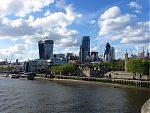31. Juli 2014
Run to work: Review of first month
 Time to have a look how my experiment worked out in the first month. Running to work has lived up to my expectations and has never yet failed to lift my spirits. There is room for improvement, but the 14 runs totalling in more than 70 km were worth every kilometer. Here are the few lessons learned.
Time to have a look how my experiment worked out in the first month. Running to work has lived up to my expectations and has never yet failed to lift my spirits. There is room for improvement, but the 14 runs totalling in more than 70 km were worth every kilometer. Here are the few lessons learned.
More than a month ago, I wrote a very short blog post on an experiment where I ran to work instead of taking public transport or the bicycle. I extended the experiment over a month. The short version: this experiment (unlike others) succeeded and exceeded my expectations.
The longer version follows, and I shall start with my motivation. London is a huge urban area with a vast public transportation network, which reaches capacity limits during the peak hours when people commute to work. I don’t have to use the tube on my daily commute, and the trains tend to be less packed with people. Nevertheless, it’s not exactly comfortable. Plus, more than half the time of my journey consists of slow-motion walking in crowds to the train and from the train. Another issue is that if I commute by public transport, I run the risk of not getting an hour of fresh (or not so fresh) air every day. And given that I love sports, when to do daily exercise?
Running or bicycling to work addresses all of the mentioned issues. The capacity limit on the sidewalk is not yet reached. No more slow-motion walking. And some fresh (or not so fresh) air is guaranteed. As is the exercise. And all of that at no expense of any extra time, given the fact that I am almost as fast running the 5k as I am by public transport. This sounded too good to be true, so I spent a month to test running to work.
There were some minor roadblocks to overcome. The first one concerned the logistics. I bought a 10L backpack (Deuter Speedlite 10; I find Deuter’s backpacks are hard to destroy) in order to take an extra set of clothes and a pair of shoes with me. It is important to have a small and narrow backpack with straps — I tried running with a wider backpack without any straps at all but it interfered with my arm swing and the weight shifted sideways while running. It did not take me too long to get used to having a backpack while running.
Another issue was how to quickly gather enough energy in the mornings, directly after waking up. Usually, a cereal bar, a glass of milk, or a spoonful of honey keeps the hunger at bay and yields enough energy to get started without thinking about breakfast all the time. What works best here is still subject to experimentation.
A mobile app to keep track of the distance and the number of runs turned out to be much more useful and fun than I thought. It keeps me brutally honest — mostly in terms of how often I actually run to work. In July, I ran 14 times to work or home from work (there are 24 workdays in July 2014). This is something I can improve upon, the goal being to manage to run almost every morning.
The air in London isn’t the best. Fortunately, 1.4 km of my “commute” go diagonally through Battersea Park. Here, the air is quite good and not as polluted as directly near one of the bigger streets in London. I really wished that more people would run to work. This reduces pollution (a little bit), which in turn would benefit the people who run (and others, too). The conclusion is definitely: highly recommendable. The next step in my experiment is to run so often to work or from work home that I can save the money for the public transportation subscription.